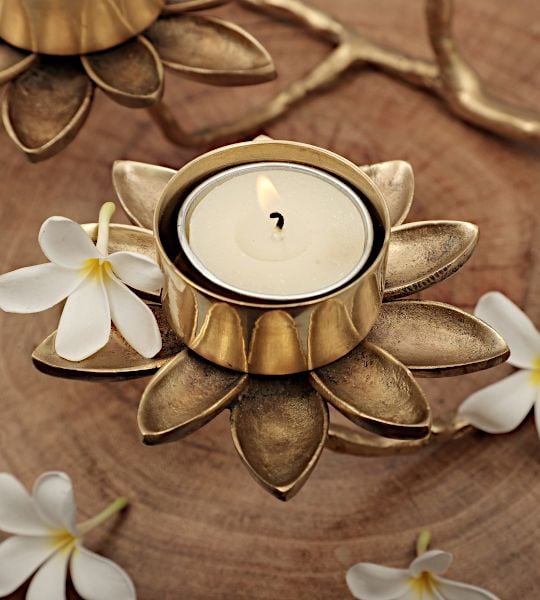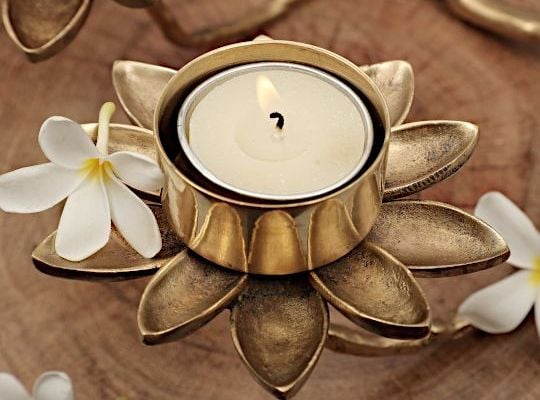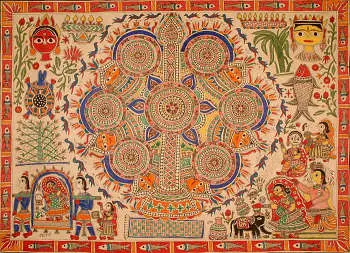 Sarvanga Alpana |
Folk art is the creative
expression of those who uninfluenced by princely ostentation and
ecclesiastic conservatism, revealed in lines and forms what they had
within and around. Her ten-twelve thousand years old creative culture
and a wide-spread art geography apart, India has hundreds of ethnic
groups, each with its own taste, aspirations, joys, sorrows, struggles
and a creative talent. Not in 'word', they discovered in 'form' their
diction, their ultimate means to discourse mutually and with the
'divine'. Education or training wasn't their tool. They had instead
massive imagination, passion to embellish, and inborn ability to give
to routine forms symbolic dimensions, and to things, scattered around,
status of art imagery - all that transformed into artists, not just
individuals but communities, generations after generations. In a world
every minute seeking means to distort and destroy they have kept along
their own tenor singing to their own tunes, dancing to the notes of
their hearts, and discovering in jumble of things, rough crude lines,
and raw colors, a world that breathed purity, harmony, respect and
concern for life, and a strange stoicism.
Defining Folk Arts
It is far easy to identify a
folk form but as much difficult to define. Its definitions vary from
the art of tribes, primitive people, ethnic groups to an art by family
tradition. Race language, a phrase that Gurushaday Datta, a bureaucrat
of colonial India and author of a number of books, used for folk arts,
underlines folk arts' power to communicate. By race he obviously meant
India's indigenous masses other than her west-influenced metropolitan
or urban minority of his days, that is, 1920s-30s. Now this minority of
those days comprises the mainstream of Indian populace, and the
majority of those days is now-days' minority. Thus, what was to Mr.
Datta the language of indigenous majority is now the language of
primitive few.
People's Art As Against Ecclesiastic And Court Art
As against the art of class -
imperial or ecclesiastic, Gurushaday Datta's phrase identifies folk art
as the art of indigenous common masses, whose first specimen was the
nomad. Nomad's rock-shelter art preceded the earliest examples of
priestly or princely art by nine-eight thousand years. Even the painted
Indus wares or terracotta figurines, the transforms of the nomad's art,
preceded the art of court and temples by many centuries, though
subsequently the latter completely isolated the former. Around
11th-12th centuries the illustrative Jain painting revived some of its
elements - irrational anatomy, angularity, bold lines, over
gesticulation. Then onward, elements of this common man's art continued
to have, except in the imperial Mughal painting, a perceptible presence
in Indian painting, even the Sultanate, and the contemporary.
 Chhatha Parva - A Typical Folk Festival of Mithila |
Folk art discovers its themes from things around. Every ethnic group
has its own stimuli - things and occasions that emotionally move, which
give each a different character. However, folk art in its entirety
celebrates joy, festivities, ceremonial occasions, and shuns
sensuousness, voluptuous modeling, more vehemently nudeness and all
forms of obscenity. Diction of flesh isn't its idiom. The folk artist
creates forms from within the rituals, myths and legends, by which he
adorns, or rather sanctifies, daily living - things that matter in life.
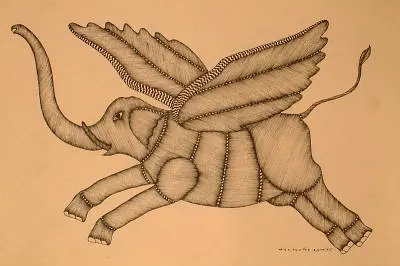 Flying Elephant |
Reason, the tool of science and
classical arts, or even speculative imagination that breeds metaphysics
is not its tool. Here spontaneity substitutes reason. It uses instead
the creative faculty of mind - art imagination, which Coleridge, the
known 18th century Romantic poet of England , calls 'esem-plastic
imagination' - faculty that assimilates and creates. This power to
assimilate gives to folk art its unique mythology - a world beyond
average man's perception, in which the sun and moon have a simultaneous
presence, trees grow over a donkey's head, a tree with a human trunk,
or birds, its foliage.
Mediums And Mind's Width
To be creative is folk mind's
innate nature, to which medium, technique, training... are irrelevant.
In whatever around, a piece of paper, cloth, wood, clay, metal, thrown
away pieces of a waste, it discovers its medium. Wall is very often its
canvas, and for rendering a painting on it a few pieces of thrown away
ropes might suffice. The Sarguja artist will mould them into desired
forms, a bed of flowering plants - stems, branches, twigs, leaves,
flowers, fix them on the wall and paint them with colored muds - white,
ochre, yellow. Ignorant of it, he creates not three-dimensional effects
but a painting with three dimensions. In pieces of rejected iron a
Bastar tribesman finds his material for a statue. Such multiplicity of
material and ability to transform it into an art medium gives to folk
art such generic width, which a single essay might not encompass.
Hence, this study confines to a few of its modes.
Art Of Chhattisgarh: Bastar
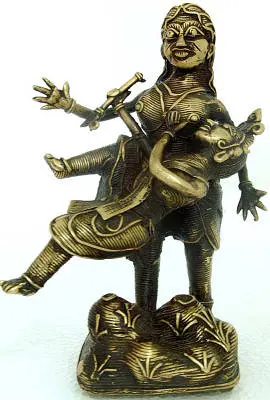 Merciless Putanaa |
Every region in Chhattisgarh, a
province in Central India, has a distinct art-form, Sarguja having a
special painting style; Raigarh, metal-casts; Kanker, wood-art;
Kondagaon, terracottas; though it is due to Bastar that Chhattisgarh
has in the world's folk-art map a place which no other art school of
Indian folks can equal. Bastar, a region with over 70 percent tribal
population, has unique talent for almost all forms of art, though it
best reveals in beaten-metal artifacts, a technique which
village-blacksmiths used since ages for manufacturing hand-tools,
agricultural equipments, kitchen wares, things of day-today use.
Chhattisgarh has an abundance of iron ores. Traditionally, Chhattisgarh
tribes gathered rejected mass of iron, purified it by heating,
manufactured articles of daily use by beating it, and exchanged them
for food-grain etc. Simultaneously, from its surplus, they made
children's toys, forms of birds, animals, human icons, articles like
oil-lamps, tiny boxes, containers. Maybe, one day these artifacts
caught some art-lover's fancy and reached his drawing room and thus
this art began getting patrons. Bastar's paintings, bamboo-art,
wood-craft, brass-casts rendered using lost-wax technique, terracottas
all have a distinction of their own.
Bastar artist hardly abides by prescriptions - iconographic or
anatomical.
Even when portraying an upper class lady reading a book, he pursues his
own anatomical or iconographic whims. Caricatured extra large legs and
a coiffure, as large as her head, reveal his picture of the lady. Forms
are exceptionally simplified. An upright rectangle with four
exceptionally large strips defining legs and arms, and a form for head,
sometimes gilded metal-pieces used for identifying eyes and other body
parts, represent a human figure. Strips, comprising legs, are sometimes
turned on either side to become statuette's pedestal. Though isolated,
festive figures of musicians, their enthused faces glowing with
delight, force the viewing eye to see around them a celebration.
Indigenous Indian masses have behind them a long tradition of thought,
beliefs, conventions, customs, practices, diluted and instilled into
the routine of their lives. However, it is perhaps only a Bastar artist
who has a unique talent in giving to his form such thematic width that
in it reflects this entire past and the gist of its thought. Into a
form, something like a tribal rearing a bird, or transporting a dog,
sick, wounded, or tired, made from ordinary thrown-away pieces of tin,
the Bastar artist is able to entwine India's indigenous belief that
life is obliged to mutually sustain as without life there is no life.
Indeed, what distinguishes the Indian folk art from the entire body of
decorative art, from anywhere, is this thematic expansion - the
meaning, or the message that it reveals.
Folk Painting
Indian folk paintings are
divisible into three categories: professional, or commercial; votive
reproductions of deity-images; and, domestic. First two painting-types
are remunerative, while the third, aesthetic. Professional painting is
free to choose any theme, religious or secular; votive painting adheres
to the image-type it seeks to reproduce. Though now commercialized, a
domestic painting - a paper transform of traditional floor and wall
paintings, was initially ritual, decorative, and for personal delight.
Elaborate Madhubani compositions, indigenous paintings of Gonds of
Madhya Pradesh, Bengal folks, and pictographs of tribes like Warli of
Maharashtra, Saura of Orissa, Kurumbha of Tamilnadu, Santhals of
Bengal-Bihar, and Bhils of Gujarat-Madhya Pradesh define the domestic
idiom of folk art.
Professional Paintings
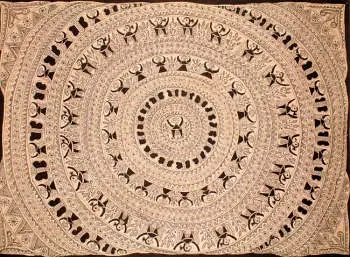 Tattoo Mandala |
Professional or commercial paintings comprise two types, the paintings narrating a tale that itinerant village performers - dancers-singers-actors, rendered for pictorially supplementing their performance, and the other, Godana or tattoos that tattoo-artists rendered for money.
 A Rajasthani Phada Depicting Mahadurga |
The former is a narrative painting on a scroll-type large canvas, paper or cloth, unfolding horizontally or upright. Its themes are usually India's great classics, legends, or local folks.
Gangavatarana And Other Myths |
This comprises the earliest example of art for public away from court and temple. Local traditions apart, Paithan paintings of Maharashtra's chitrakathis, Rajasthani pars, and scrolls of patuas or jadu-patuas of Bihar and Bengal are some of its more significant examples.
 Handwoven Black Paithani Sari With Zari Pallu |
Chitrakathis' paintings from Paithan, the ancient Pritishthan, a major township and business center those days, illustrate epical tales, especially the Mahabharata and the Ramayana, and sometimes narratives like Vetal-Panchavishi. Now Paithani is better known for its textile designs and a Paithani sari is a prestigious collection for any wardrobe.
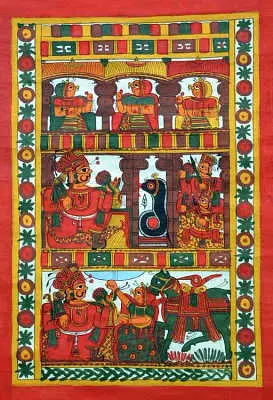 Basag Phad |
Rajasthani counterparts of Maharashtra 's chitrakathis are known as
Bhopas. The Rajasthani pars - scrolls, narrate the epical legends of
Devanarayana and Pabuju, the examples of unique velour and
unprecedented sacrifice. Pabuju's legend being more prevalent, these
scrolls are often called as Pabuju-ki-pars.
Patuas, or pata - scroll
painters, of Bihar and Bengal illustrate both, episodes from great
epics as well as local folks. Some patuas confine themselves to magic
tales and are hence known as jadu-patuas, magic-scroll painters. In
West Bengal Midanapur region is a known seat of scroll painting.
Midanapur patuas not only narrate the tale when displaying the scroll
but also, when illustrating it on their canvas to capture its essential
spirit. The tradition of these itinerant singers still prevail and is a
significant source of entertaining a large part of village population.
Godana
Godana, or tattoos, till recent
past the art of backward rural masses, is also a commercial art by
which a tattoo-artist earns his livelihood. Till recent past, among
tribes and low-caste Hindus Godana, besides beautifying body, was an
essential requisite of a married woman for a marriage was sanctified
only after the bride had at least two sets of Godanas on her body, one
for her in-laws, and other, for her parents. Unless tattooed, her
in-laws did not accept even water from her hands. The Godana motifs
were religious, auspicious, and sometimes secular. Demand for new
motifs compelled tattoo-artists to conceive new forms and maintain an
album. Thus, paper transforms of tattoo motifs emerged and a new folk
art form was born. What an irony, tattoos that with their ethnic look
define today one of world's latest fashion trends and adorn body parts
of ramp-icons world-over, male or female, was despised, till a couple
of decades back, as a crude ugly thing of barbarians.
Reproductions Of Deity-Images : Orissa And Nathdwara
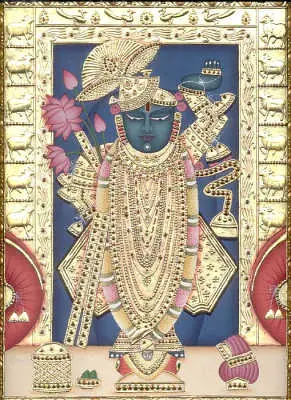 Sri Nath Ji |
Votive reproductions of Shrinathji at Nathdwara in Rajasthan,
 The Trinity of Balarama Subhadra And Krishna at the Temple of Jagannatha |
or Jagannatha at Puri in Orissa, pursuing exact image-types, define yet another class of paintings. Initially rendered on cloth these paintings were identified as pata-chitras - cloth paintings. The term pata has many connotations, its most accepted meaning is however cloth. The Oriya tradition perceives in cloth a different kind of sanctity. Cloth is one of the main components used in making temple images of Jagannatha, Balarama and Subhadra. As is the practice, plain featureless neem-wood-images of Jagannatha and others, which are annually re-painted and periodically replaced, are first wrapped with several layers of cloth to arrive at a smooth surface and then painted. These cloth-layers better retain colors and their brilliance. Thus, the visible forms of deities enshrining Puri temple are actually those on cloth realized in colors. Hence, Jagannatha's reproductions on cloth are believed to have the same sanctity as the original temple image.
 Worshipping Shri Nath Ji |
Jagannatha's image is votive while Shrinathji's, in act. This pre-determines their image-types in two art schools. Oriya reproductions of the Trio are simple votive portraits, while those of Shrinathji at Nathdwara represent his lila-rupa. Even when Shrinathji is reproduced with a large size central image, the Nathdwara pata portrays aspects of his lila around. Correspondingly, the canvas size of Nathdwara-patas is relatively larger.
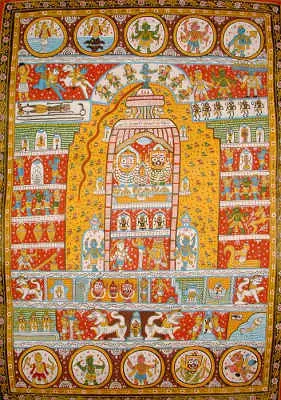 Sri Jagannath Pati |
So vary their uses.
Orissa-patas are usually the images for domestic shrines but
Nathdwara's, usually the votive-aesthetic hangings. With this specific
use Nathdwara wall-hangings are called Pichhawais, not pata-chitras. In
Orissa pata-chitras, the focal point is its traditional style of
painting and its image-type, which is static from at least the 11th
century. Other subjects, secular and even romantic, also figure in
them, reproduction of temple images is however their main theme.
 Meditating Chaitanya Mahaprabhu With Shri Krishna |
For other icons, human or
divine, these pata-chitras pursue Orissa's regional iconography - large
eyes, angular chin, pointed bird's beak type raised nose, and robust
look.
The form of temple images is akin to some folk tradition, which some
scholars relate to Sauras, an aboriginal tribe of Orissa. They contend
that Sauras worshipped wooden images of the Trio with identical
iconography till at least 11th century. In 11th century, they were
shifted to the newly built temple at Puri and installed as Jagannatha.
Kalamkari
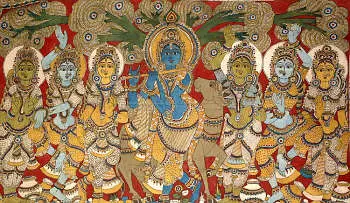 Fluting Krishan With Gopis |
Kalamkari, a large-size cotton fabric patterned through the medium of dye, used as a hanging usually in a temple but also in private apartments on auspicious occasions or for decoration, is partly the Pichhwai type and partly pata-chitra, though in its style of rendering it is akin to the narrative cult of performers' scrolls.
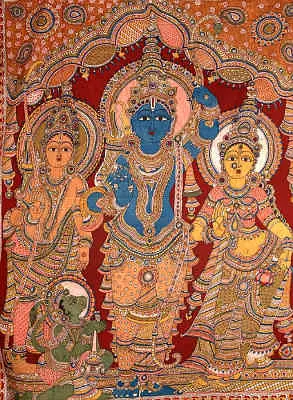 Shri Rama Durbar |
More expansive than a scroll,
sometimes with a length and width in meters, a single Kalamkari,
divided into many registers and spaces, covers an entire epic like the
Ramayana or the Mahabharata, its fifty-sixty episodes or even more.
Isolated deity-images, Vishnu's ten incarnations, are also painted but
its usual themes are rituals like tree-worship, legends like Devi
annihilating Mahisha or Shumbha and Nishumbha, episodes from
Krishna-lila - stealing Gopis' garments, killing a demon, besides the
great epics and other classics, and sometimes flora and fauna and
similar decorative motifs.
 Kalamkari and Traditional Design Heritage of India |
Different from a Pata-chitra
which derives its name from its medium 'pata', and a Pichhwai, a name
characteristic of its use as a wall hanging, Kalamkari derives its name
from its technique, though now, not so much for its technique, a
Kalamkari is known for the type of motifs and iconographic forms which
have almost concretized. The term Kalamkari literally means the work of
'kalam' - pen or feather, though besides, a Kalamkari is also
block-printed. Earlier only the outlines were block-printed but for
finer details colors were applied freehand with a brush or feather.
Obviously, it was for this finer part of its work that the artifact was
called Kalamkari. Now this distinction has largely blurred. As in case
of brush and block, distinction in types of colors has also blurred.
Ahmedabad in Gujarat, and Kalahasti and Masulipatan in Andhra are the
known centers of Kalamkari.
Gujarat has two other classes of painted cotton, 'chhit' - spotted
cotton, and 'chintz' - fabric with pictures. Being one among others,
Kalamkari did not have in Gujarat such distinction as in Andhra with
the result that Kalamkari is more widely known as the art of Andhra
rather than Gujarat.
Domestic Painting
Domestic painting has its roots
in rock-shelter pictographs. Harappan drawings on its pottery, as well
as animal and human forms in its terracotta figurines, reveal
continuity of these pre-historic pictographs. Human and animal figures
on early coins adhere to same iconographic forms. Tattooing, perhaps an
art prevalent across ages, has similar line-drawing technique as had
rock-shelters. Floor drawings and wall paintings, a part of
marriage-like auspicious rituals, represent the final stage in the
growth of folk-art from rock-shelter drawings to canvas painting. It is
essentially this common tradition that imparts to art-styles of most
tribes - Bhils, Warlis, Gonds, Kurumbhas, Sauras, Santhals and others,
striking similarity.
A folk painting is composed of overlapping forms, irrational anatomy, irregular imagery, and random motifs but its polyphonic character has an amazing coherence and unity; perhaps, because its images are endowed with the power to speak to each viewer in his diction and tell him his tale. This apart, born of the tradition under which it was part of a ritual, or deity-feast, marriage, birth, festival type sacred or auspicious occasions, a folk painting is endowed with underlying spiritual tones, which thread into an unseen unity its apparent diversities. This spiritual connotation is folk painting's essence, spirit and soul. To the artist, individual in his act is heroic, but along it myriad other events keep unfolding, and the artist finds his world widening beyond this individual and beyond his act. To the folk artist the world is not an individual's island. So to him is time, a continuum and indivisible process. Hence, in his art, events of past, future and present exist in simultaneity, and legends, myths and fantasy - things of far gone days, are found interwoven with the contemporary. In his epic one story unfolds into another and so on in an endless chain.
 Ritual Painting of Goddess Lakshmi for Worship |
In folk art, ritualism rarely reflects but it has always sustained in ritualism.
Folks believed that gods
blessed with their presence a house only when it consecrated for them
sacred spaces. This gave birth to the cult of floor drawings and wall
painting which separated from profane the gods' sacred spaces and
realized their divine presence in motifs drawn along. Floor-drawings,
variedly known as Rangoli, Alpana, Ossam, Jhunti, Kolam, Mandana,
comprised sacred symbols, mystic diagrams, auspicious motifs, flora and
fauna, geometric patterns. In addition, wall paintings, figural by
nature, comprised divine icons, legends. Paintings' such contents
apart, its entire tradition had ritual connotation. The skill of
painting was believed to be a divine gift made to a woman, essentially
a married one, a Suhagin. As both, marriage and painting, represented
fertility, a Suhagin alone could accomplish a painting. In all ages,
one Suhagin, or another, was found claiming appearance of a female
divinity, usually Parvati, in her dream and gifting to her the skill to
paint and giving her an understanding of reeti - convention, and
knowledge of cosmic laws. Commercialized, the painting of tribes might
have lost its ritual status but not its ritual connotations, its
intrinsic quality and ability to transcend the flesh and reach the soul.
Domestic Folk Painting: Tribal And Non-Tribal
 Marriage Procession of the Warlis |
Tribal and non-tribal -
Madhubani, Bengal, are two distinct painting-types. Tribes' art
breathes closer affinity with rock-shelter art. Geographical boundaries
are irrelevant in both but in tribal art almost absolutely. In Warli
painting, a village is seen running into a town, and town, into a big
city, and so on. A two-color composition as is Warli, or multi-colored,
a painting of tribes has a set of more simplified imagery and
composition.
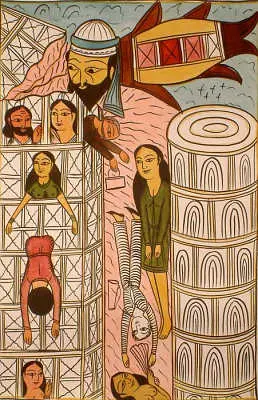 The Tragedy of 9-11 |
Bengal folks, or even Madhubani, adhere to norms of anatomy and
iconography, and even to hierarchical or social order. Not these alone,
tribal paintings do not abide even by figures' relative sizes. They
conceive a scorpion or caterpillar with the same size as a cock or
horse, and see no anomaly in it, as if some internal logic regulates
them. Folk paintings, especially Warli, use spatial divisions of canvas
for portraying simultaneous operation of a number of activities of the
same genre - ripening of crop, harvesting, transportation, stacking of
bundles, thrashing, separating corn, revealing a kind of rhythmic
synchronicity, something not seen in non-tribal folks. They have as
different attitudes in portraying violence - terror, hunting, animal or
human sacrifice. Madhubani compositions have abundant motifs relating
to violence. Contemporary terror theme apart, the Bengal folks portray
acts of male cruelty against a woman and even human sacrifice. Scant
fishing activity or a hunt-transporting icon apart, in tribal paintings
violence rarely figures. Whatever in their real life, the tribes do not
pollute their art with scenes of killing or cruelty for to them a
painting is the seat that gods enshrine.
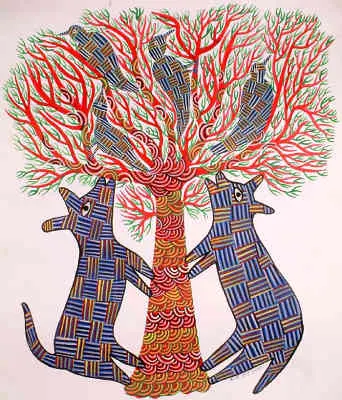 Flora and Fauna |
In non-tribal paintings nature
is a rarity, and landscape, rarer. Tribal painting is more sensitive
about nature. To their randomly jotted figures or activities, landscape
affords compositional unity. In entire tribal art man and nature are
alike essential component of existence. In field or forest, grazing
cattle, harvesting, or transporting firewood, or fodder, it does not
distinguish man from his surroundings. Apart, in its treatment of
nature it is exceptionally sensitive. Paintings of Gond tribe treat
animals with same sensitiveness as one treats a child, conceiving them
as multi-colored, grafting on a tiger's face a child's innocence,
curiosity and enthusiasm for life, or allowing a mouse to overlap into
the form of Ganesh, its patron. The use of bright basic colors without
shading is characteristic of the entire body of folk painting but in
tribal art, Gond in particular, colors are more vibrating and create
movement and rhythm.
 Lost in the Forest |
When shifted to paper Warli
artists retained their initial scheme of geru - red mud, for
background, and white for forms.
Kurumbhas render both, a two-color as well as multi-color composition.
Bhils distribute the canvas space into small circles, triangles,
minuscule towers or temple motifs and use in them deep bright colors in
striking contrast.
In tribal paintings, forms are extremely simplified. In Warli paintings
a configuration of fleeting lines defines a bird, and a series of
revolving circles, the sun. In other paintings, as Bhils', the sun is
conceived as a spiked circle with human face. Two length-wise elongated
triangles of the same size, one, upright, and other, inverted, a circle
for head, and two lines, for arms, and other two, for legs, define a
human figure. In Kurumbha paintings an upright rectangle substitutes
this two-triangle-formation of human figure. In paintings from Sarguja
and Bastar, in Chhattisgarh, upper triangle has a size larger than the
other. Sauras conceive human figure with just one elongated triangle.
The style of costumes and modeling of figures in Bhils' paintings are
somewhat urbanized. As simply are identified genders. A single circle
for head denotes a male, while an additional one, denotative of
hair-dress, annexed to the former, denotes a female. As simple are
animal forms. Two horizontally drawn triangles, as those of human
figures, constitute an animal figure. A rectangle, straight or curbing,
sometimes substitutes this two-triangle-formation. A few vertical lines
under the hind legs, denotative of thuds, denote a cow or female
animal. Hardly optical, these distinctions emerge from interpretation,
a tribal painting's basic feature. In any case, the tribal art paints a
thing's essence, not the thing.
Madhubani And Bengal Folks
 The Terror of Osama bin Laden |
The non-tribal Madhubani and
Bengal paintings are theme-oriented and form-consistent. Even randomly
jotted, motifs and forms reveal a conscious effort in their
composition. However large the number of motifs, a Madhubani painting
has at least a central theme. Bengal 's Kalighat folks had begun
transforming into bazaar art by around 1890-1900. Hence, it inclined
towards sophistication and visual accuracy. It developed accomplished
imagery as suited the market. Kalighat painting initially reproduced
Kali-images but subsequently their number or even those representing
religious myths, legends, reduced to almost nil. Instead, rigid social
customs, festivals, celebrations, pictures of Europeanized life-style
were more favored. The period from late 19th century onwards was a
great era of art in Bengal. Institutions of art like Shanti Niketana
apart, Bengal had a galaxy of eminent painters in modern art-styles.
Their influence transformed Bengal folk into a semi-civil art. Now its
themes are terrorism, demonisation of terror symbol like Osama bin
Laden, warning against AIDS.
Madhubani, the painting style practised around Mithila in Bihar with
village Madhubani as its center since ages, emerged into global focus
around 1970 and is now world-wide most demanded art-form of India. In
1970s itself it impressed art world by the magic of its pure colors,
rich and elaborate composition and ability to lead the viewers to an
India - the truest, to which they have no otherwise access. Now hardly
in an average man's mind, Mithila had, instilled into its people's
blood, a set of myths, legends, beliefs, traditions, customs, rituals,
festivals, practices, and these are what flow from the Madhubani
painter's brush as its vision of India, the India that wakes gods after
four monsoon-months by performing rites around sugarcane plants and a
couple of footprints - Lord Vishnu's, walking on a chain of lotuses
leading to an empty sanctum sanctorum, the India where a maiden, before
entering into marriage-ties, worships the earth seeking from the Mother
goddess blessings of fertility, the protective Pipal tree, for giving
her a roof, or where a deadly cobra is seen dancing to the notes of
snake-charmer's pipe. Whatever, a myth, legend, event or occasion, a
Madhubani painting represents in a series, various steps, episodes, or
a repetitive chain.
It is in the cult of floor-drawing and wall painting that the roots of
Madhubani painting lie. In its broad layout it pursues floor-design -
Alpana format. The central theme apart, like an Alpana a Madhubani
painting adorns its entire field with motifs and images, even
incoherent or random. It inherits its divine imagery, myths, legends,
narratives and all its dialogues - its unique feature, from
wall-paintings. In Madhubani paintings images often eject and begin
discoursing. Conceptualization apart, the Madhubani painting also
reproduces now highly stylized forms, even abstract, experiments with
them, deity-forms in particular, resorts to deliberate symbolism and
inclines to be more decorative. Terrorism like concurrent themes often
frequent its canvas. Short heights, expressive and angular faces in
profile, large bulbous eyes, sharp noses, and typically styled hair
define Madhubani's male and female figures. However insignificant,
almost every image has its role. Massive symbolism, underlying rhythm,
great width of imagination, strong lines, versatile and vibrant
imagery, vigorous composition, elaborate borders are other features of
Madhubani art idiom.
BIBLIOGRAPHY
- Gurusaday Dutt : Folk Arts and Crafts of Bengal
- Das Gupta : Alpana
- R. N. Ganguli : Pata and Patuas of Bengal , in Indian Folklore
- Heinz Mode/ Subodh Chandra : Indian Folk Art
- Upendra Thakur : Madhubani Painting
- Michel Postel/ Zarine Cooper : Bastar Folk Art
- Elwin : The Tribal Art of Middle India
- S. Fuchs : The Gond and Bhumia of Eastern Mandala
- The Cult of
Jagannath and the Regional Tradition of Orissa : ed. A. Eschmann, H.
Kulke and G. C. Tripathi
- Five
Contemporary Folk and Tribal Artists of India : ed. Jyotindra Jain
- Marg Volume :
Homage to Kalakari (April, 1979)



